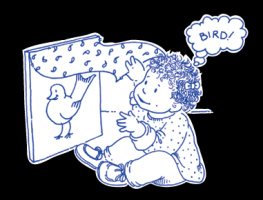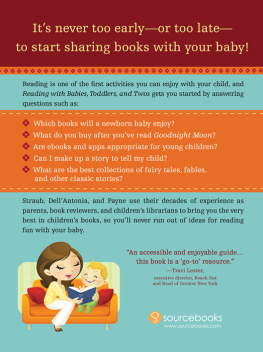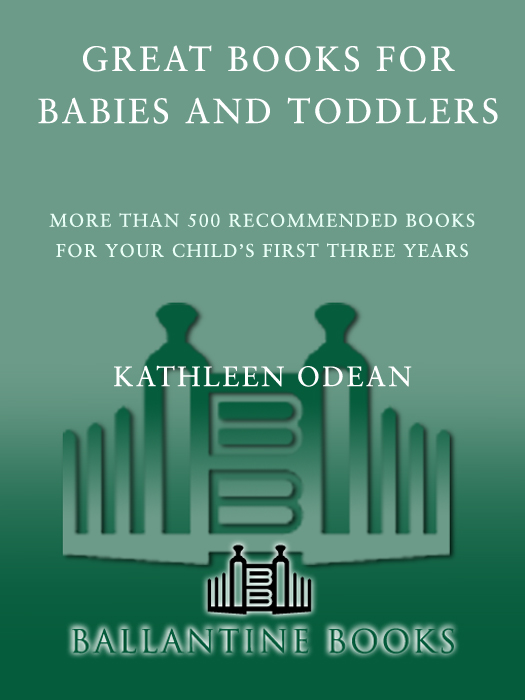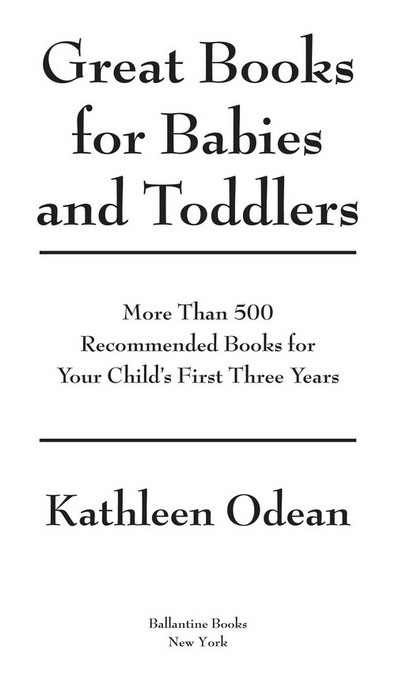Praise forGreat Books for Girls
When I was a girl, books were my teachers, my friends. They gave me hope, dreams, direction, and eventually powerpower to become who I wanted to be. This guidebook, compiled by a knowledgeable, story-spirited woman, will allow adults to help girls find the great books that nourish the spirit. I recommend it for all those who want girls to grow up strong, free, bold, and kind.
M ARY P IPHER
Author of Reviving Ophelia
With superb literary taste and an eye for books depicting strong-minded girls and women, [Odean] recommends more than six hundred outstanding titles.
U.S. News & World Report
Praise forGreat Books About Things Kids Love
An invaluable resource for both fiction and nonfiction.
Minneapolis Star-Tribune
[Odeans] choices are superb. An excellent book.
The Sacramento Bee
Kathleen Odeans compilation Great Books About Things Kids Love is an excellent resource for home and school libraries.
The Denver Post
A strong parents resource that also belongs on the professional shelf.
Booklist
A Ballantine Book
Published by The Random House Publishing Group
Copyright 2003 by Kathleen Odean
All rights reserved under International and Pan-American Copyright Conventions. Published in the United States by The Random House Publishing Group, a division of Random House, Inc., New York, and simultaneously in Canada by Random House of Canada Limited, Toronto.
Ballantine and colophon are registered trademarks of Random House, Inc.
www.ballantinebooks.com
Library of Congress Control Number: 2003090307
eISBN: 978-0-307-48563-2
v3.1
CONTENTS
Introduction
The single most important activity for building the knowledge required for eventual success in reading is reading aloud to children.
N ATIONAL A CADEMY OF E DUCATION ,
B ECOMING A N ATION OF R EADERS
The ideal time to begin sharing books with children is during babyhood, even with children as young as six weeks.
N ATIONAL R ESEARCH C OUNCIL ,
S TARTING O UT R IGHT
As a parent, you want to give your child the best possible start in life. At the same time, you want to enjoy every moment you can with him or her and create wonderful memories. One of the simplest, most effective ways to do all three is also one of the most rewardingto read aloud to your child, beginning early and continuing for years to come. A host of benefits flows from the practice of reading regularly, yet you dont need to work at achieving them. In fact, the key is for both of you to have fun, to relax and enjoy the lilt of language and the pleasure of pictures. If you make books as much a part of your daily routine as meals, play, hugs, and happiness, your child will soak up information about language and books while youre having warm, happy times together.
The best way to make reading aloud a cherished routine is to read wonderful books. And the most wonderful books are those that entertain parents as well as children, since as a parent, you may very well be reading these early books again and again. The best books use language that appeals to the ear and illustrations that appeal to the eye, and often include touches of humor for parents, without losing sight of their child audience.
The goal of this guide is to make reading aloud easy by identifying the best books for a childs first three years. In the last decade, the number of books for the very young has expanded enormously, providing thousands of choices, some excellent, some not. Outstanding writers and illustrators have turned their talents to creating books perfectly suited to the attention spans of babies and toddlers. But other new books, thrown together quickly to reach a growing market, make the experience of reading aloud tedious rather than satisfying. Some books, even for the very young, are designed mainly for promoting a product. This guide brings together more than five hundred top-notch books that have illustrations and text created with an understanding of what young children need and like.
What will your child gain from hearing and seeing books early in life? First, the powerful pleasure of being with you in an activity you both like. Sharing books is an excellent way to spend time together in a busy world, a time apart. During the enjoyable experience of listening, your child is immersed in language, which is how babies learn to understand words and then speak them. Its critical that babies hear spoken language, but parents sometimes run out of things to say to someone who doesnt respond in words. Reading is a great way to supplement conversations, with the added pleasures of artwork, rhythm, and rhyme.
By reading aloud, you communicate your enthusiasm about books, sending the message that youthe most important adult in your childs lifebelieve reading is important. Your child learns that books are entertaining, interesting, and comforting. Reading to young children also sets them on the path of emergent literacy, a term that sums up all the ways children become at home with language, reading, and writing well before they can decipher or print a recognizable word. They start to see how books work and what they are for. They take pride in learning to turn pages and come to realize that it advances the story. Toddlers begin to connect the black printed marks with the words you speak, their first glimmerings of the power of the printed word. Youll see toddlers pretending to read to themselves and their stuffed animals, showing off their new understanding about pages, print, and how the pictures help tell a story.
Enjoying books is one of many related pleasures in a childs life. Babies and toddlers also need to explore their physical worldindoors and outdoorsplay with toys, listen to songs and sing along, crawl and walk and climb, splash in water and dig in sand, interact with people and pets, and much, much more. Reading is a significant ingredient in a rich mix of play and activities that acquaints children with their world.
Babies and Language
Recent research on babies and language reveals that far more is going on in babies minds than scientists previously believed. Amazingly, babies just two days old can tell the difference between the language they heard while they were in the womb and a foreign language, according to How Babies Talk, by Drs. Roberta Golinkoff and Kathy Hirsh-Pasek, a fascinating study of language acquisition in the first three years of life.
Babies start out with a remarkable facility for learning language. One study showed that four-month-old infants can discriminate among the sounds used in all different languages, but around ten months, they focus on those sounds peculiar to the language they hear around them and lose their ability to distinguish sounds they wont need. Canadian babies responded at six months to sounds specific to Hindi that Canadian adults cant hear, but by twelve months, the babies could no longer distinguish the Hindi sounds.
Not surprisingly, babies and toddlers who live in a setting where they are exposed to a lot of conversation, reading, and nursery rhymes acquire a greater vocabulary than those who dont. Study after study shows that a childs vocabulary can be predicted from the number of words that the child hears. Toddlers who have had more stimulating language environments in the first two years tend to have larger vocabularies and Speaking and reading to babies and toddlers supply the vocabulary and sentence structure that they need to acquire long before they can say their first word.










